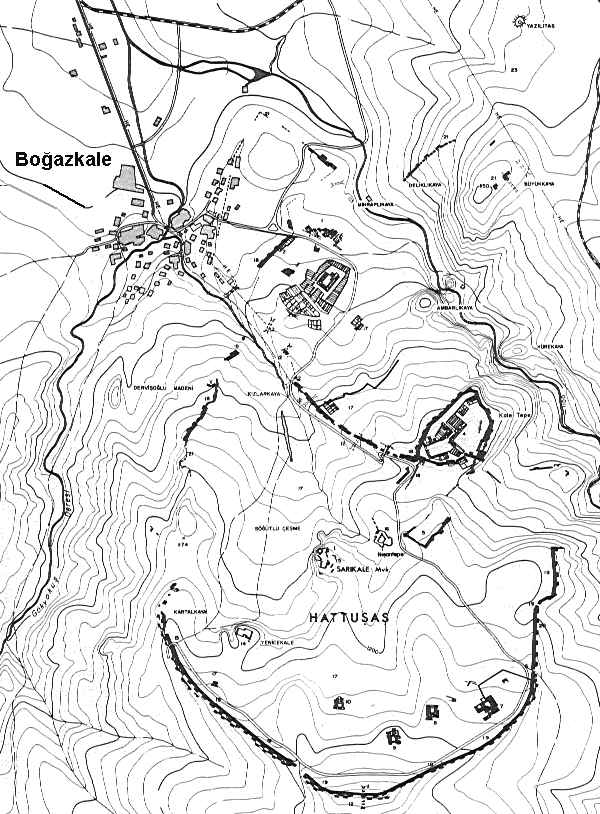Boğazkale (Boğazköy / Hattuşaş)

Plan of Boğazköy (Hattusa)
1) Settlement dating from the Karum Hattus period
(19th-18th centuries B. C.).
2) The Temple of the Weather God of Hatti and the Sun Goddess of Arinno.
3) Büyükkale (the Great Citadel), the acropolis of Hattusa (see plan of Büyükkale).
4) The Southern Citadel, probably one of the most important fortresses of
the 13th century B. C., not yet excavated.
5) Nişantepe (Target Hill), with remains of a once imposing Hittite
castle dating from the 13th century B. C. On the west side of the modern road can be seen
an 8.50 m long hieroglyphic inscription carved in the rock. This is badly weathered, but,
starting in the top right-hand corner, reference is made to "the Great King
Suppituliuma, son of the Great King Tudhaliya and grandson of the Great King Hattusili".
Since the two Hittite kings called Suppiluliuma happen to have had the same genealogy, we
are not in a position to determine which is meant here.
6) King's Gate (beginning of the 14th century B. C.). The high relief
originally adorning the west face of the north door jamb of the entrance overlooking the
interior of the city is now kept in the Ankara Archaeological Museum. On the site, the
original work is now replaced by a concrete cost. The attractive outer face of the King's
Gate is relatively well-preserved. The door jambs were made up largely of tall andesite
monoliths forming the pointed arch characteristic of Hittite architecture. The city wall
is built in Cyclopean masonry with huge, roughly worked stone blocks. The height of the
stone wall was about 6 m., and this was overlaid with sun-dried brick.
7-10) Temples dating from the 13th century B. C., constructed according
to the classic type. of Hittite sanctuary (see plan of
temples, picture of temple of Hatti) with a
central courtyard and an adyton containing the cult statue.
11) Yer Kapı, the Sphinx Gate (see picture below).
12) Lion Gate (beginning of the
14th century). Constructed like the King's Gate in the form of a pointed arch, the upper
part of which is now lost. The outer (western) fronts of the door jambs are each adorned
with the head and fore-quarters of a lion. The animal on the right-hand side, almost
intact, is a valuable example of large-scale Hittite sculpture. Like the apotropaic dogs
mentioned in Hittite texts, these lions, with their threatening open mouths, were intended
to word off evil spirits.
13) Yenice Kale (the New Castle), showing well-preserved Hittite walls,
dating from about the 13th century BC.
14) Sarı Kale (the Yellow Castle). Beautifully laid Hittite walls going
back to the 13th century B. C. are also in evidence here. The other walls in the same
castle are built of small stones, showing the remains of repair-work carried out in
Phrygian times.
 Boğazköy, Yer Kapı,
i.e., the central Portion of the southern fortifications, with the Sphinx Gate and the big
pastern (beginning of the 14th century B. C.). On the east and west, the city was
naturally defended by steep slopes which are absent in the centre of the south side.
Therefore, the Hittite architects constructed a strong bulwark for offensive sorties in
this weak section. The 70 m. - long pastern beneath the Sphinx Gate served as a sally port
against the enemy. The outer door of this subterranean tunnel, built on the corbel system
and employing huge Cyclopean stone blocks, is visible in the centre of the picture. When
this section of the defense works was in danger, Hittite warriors used this tunnel and
descended the two steep stairways on both sides of the gateway in order to attack the
enemy from the rear. One of the towers stood on the axis of the pastern, flanked by
sphinxes on the inner side. Three of these sphinxes were found during the excavations. Of
the two sphinxes formerly adorning the gateway on the city side, one is now in Berlin, the
other in Istanbul. Parts of the third sphinx are still observable in situ. Boğazköy, Yer Kapı,
i.e., the central Portion of the southern fortifications, with the Sphinx Gate and the big
pastern (beginning of the 14th century B. C.). On the east and west, the city was
naturally defended by steep slopes which are absent in the centre of the south side.
Therefore, the Hittite architects constructed a strong bulwark for offensive sorties in
this weak section. The 70 m. - long pastern beneath the Sphinx Gate served as a sally port
against the enemy. The outer door of this subterranean tunnel, built on the corbel system
and employing huge Cyclopean stone blocks, is visible in the centre of the picture. When
this section of the defense works was in danger, Hittite warriors used this tunnel and
descended the two steep stairways on both sides of the gateway in order to attack the
enemy from the rear. One of the towers stood on the axis of the pastern, flanked by
sphinxes on the inner side. Three of these sphinxes were found during the excavations. Of
the two sphinxes formerly adorning the gateway on the city side, one is now in Berlin, the
other in Istanbul. Parts of the third sphinx are still observable in situ.
|